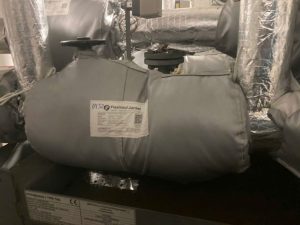When the hot season arrives, soaring electricity bills are a common worry for many households, largely due to continuous air conditioner use. Among the many solutions, the insulation jacket for AC condenser units emerges as a simple, low-cost method that offers surprising effectiveness in reducing equipment load and saving energy.
What is an AC Condenser Unit Insulation Jacket?
An insulation jacket (also known as a condenser unit cover or thermal shield) is a specially designed shell that wraps around the outdoor unit of an air conditioner. This product does more than just provide simple rain and sun protection; it is constructed from multiple layers of high-quality materials to perform its insulating and protective functions.
A typical structure of a quality insulation jacket includes:
- Outermost layer: Usually made of parachute fabric, canvas, or a composite material that is waterproof, UV-resistant, and can withstand harsh weather conditions.
- Middle insulation layer: This is the “heart” of the product, using materials like rockwool, silver-coated PE foam, or multi-layer aluminum films. This layer is responsible for reflecting solar radiation and preventing ambient heat from penetrating.
- Innermost layer: A soft fabric layer that contacts the unit’s casing, helping to prevent scratches and enhance heat resistance.
How It Works & Its Energy-Saving Efficiency
The working mechanism of an insulation jacket is very simple: it lowers the operating temperature of the outdoor unit, which directly reduces the load on the compressor—the component that consumes the most electricity.
1. Directly Reduces Compressor Load
When the outdoor unit is exposed to intense sunlight, the surface temperature and the temperature of internal components can rise significantly. This forces the compressor to work continuously at high intensity to dissipate heat, leading to higher power consumption.
An insulation jacket acts as a shield, reflecting a large portion of the sun’s heat. As a result, the temperature inside the outdoor unit is maintained at a more stable and cooler level, allowing the compressor to operate more gently and use less electricity to achieve the set temperature in the room.
2. Increases Heat Exchange Efficiency
When the overall temperature of the outdoor unit is kept low, the heat exchange process between the refrigerant (gas) and the outside air becomes faster and more efficient. This helps cool the room more quickly, allowing the compressor to reach its rest cycle sooner, thereby reducing total operating time and saving significant energy.
Benefits Beyond Just Lowering Electricity Bills
Besides the economic benefits, equipping your condenser unit with an insulation jacket also brings many added values.
Protects the Unit, Extends Its Lifespan
The protective cover helps shield the outdoor unit from harmful environmental factors such as:
- Acid rain, industrial dust.
- Salt corrosion (especially important for households in coastal areas).
- Bird droppings or other foreign objects.
Properly protecting the electronic components and casing helps the unit operate durably, reducing repair and maintenance costs in the long run.
Reduces Operating Noise
Some high-end insulation jackets also incorporate soundproofing materials. This layer helps absorb and minimize the noise emitted by the cooling fan and compressor, creating a quieter space for your family and neighbors.
Guide to Proper Selection and Installation
To ensure the insulation jacket performs to its full potential, you should note a few important points:
- Choose the right size: The jacket must fit your condenser unit model snugly. A cover that is too tight can cause heat buildup, while one that is too loose will reduce insulation effectiveness.
- Prioritize good materials: Choose products from reputable brands with clear material specifications to ensure durability, insulation capability, and weather resistance.
- Check the ventilation design: A good insulation jacket must have vents or mesh panels correctly positioned at the fan and air intake areas. This is crucial to ensure constant airflow and completely avoid overheating the unit.
- Install according to instructions: Always follow the manufacturer’s guidelines, ensuring the jacket covers all surfaces directly exposed to the sun but does not block the heat dissipation components.
This is a small investment that offers a dual benefit: it reduces monthly operating costs while protecting and extending the life of your air conditioner. Consider getting an insulation jacket for your outdoor unit today to enjoy a cooler and more economical summer.
Request consultation and quotation now!Frequently Asked Questions
Do condenser unit insulation jackets really save electricity?
Yes. By lowering the operating temperature of the outdoor unit under the sun, an insulation jacket helps the compressor work less intensively, thereby reducing power consumption and saving costs.
Will covering the AC condenser unit cause it to break down faster?
It won’t, as long as you use a properly designed product. Insulation jackets are designed with smart vents to ensure the heat dissipation process continues normally. On the contrary, it helps protect the unit from environmental elements.
In which locations is it most beneficial to install an insulation jacket?
An insulation jacket is most effective when the condenser unit is installed in locations directly exposed to sunlight, especially on a west-facing wall or on a rooftop without an awning.
Is installing an insulation jacket complicated?
Not at all. Most products are designed for easy DIY installation at home in just a few minutes, using the included straps or Velcro fasteners.
Besides an insulation jacket, are there other ways to protect the condenser unit?
You could build a permanent awning or cover for the condenser unit. However, this solution is more expensive and complex than using a flexible, specialized insulation jacket.
How often should I clean or replace the insulation jacket?
Depending on the environment and the product’s quality, you should clean the insulation jacket every 6 to 12 months. A well-maintained jacket can last for several years.










